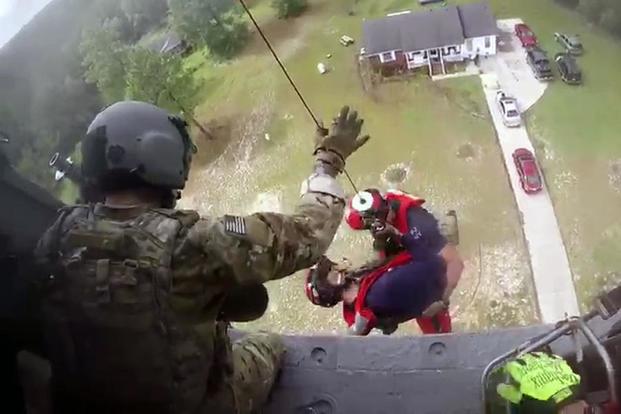Thousands of active-duty and National Guard troops are using amphibious vehicles and search-and-rescue aircraft to move people and equipment after Hurricane Florence battered the East Coast last week, even as some of their own bases were damaged by the storm.
Rainfall and rising water levels continue to threaten areas of North and South Carolina four days after Florence made landfall as a Category 1 storm.
Air Force Gen. Terrence O'Shaughnessy, head of U.S. Northern Command, said the military has been able to work seamlessly with state and federal authorities leading relief efforts; 13,000 service members are responding to some of those agencies' requests, including 6,000 active-duty forces and about 7,000 National Guard members, he said Tuesday from Raleigh, North Carolina.
Troops from Fort Bragg, Camp Lejeune, and Marine Corps Air Station Cherry Point in North Carolina; Fort Jackson in South Carolina; and Moody Air Force Base in Georgia have pitched in.
In coordination with local, state and federal authorities, the Defense Department not only pre-staged meals and water, but also vehicles that could operate in floodwaters and helicopters for search-and-rescue and transport missions.
"As it turns out, that's exactly what we needed to have," O'Shaughnessy said.
Army personnel in high-water vehicles have helped evacuate about 300 people. And Marines from Camp Lejeune used amphibious vehicles to assist people stranded by floodwaters. In one mission, they were able to rescue 20 people at once, O'Shaughnessy said.
Cherry Point was also turned into a makeshift shelter after another nearby began to flood.
"A local state center was flooding so we took them to Cherry Point where we could house them overnight and feed them," he added.
The storm didn't bring the damaging winds initially feared, but it hovered over land for days, moving at just 2 mph and dumping about 3 feet of rain in some of the hardest-hit areas. That has caused rivers and streams to swell and spill over. In some areas where waterways haven't crested yet, the threat still exists.
"The concern has turned to flooding, and that's still the concern over the next 48 hours," O'Shaughnessy said.
That threat even led the Defense Department to move some of its own supplies and equipment out of the danger zone, he added, since some of the trucks and food were stored at Fort Bragg, which was affected by the storm.
The Coast Guard continues to lead search-and-rescue missions in coordination with state agencies. The Navy's amphibious assault ship Kearsarge and amphibious transport dock ship Arlington, which headed out to sea in advance of Florence, are also now about 10 miles off the coast of the North and South Carolina border, where they can assist.
There are MV-22B Ospreys aboard the Kearsarge, O'Shaughnessy said, which can help move people and materials in hard-to-reach areas.
Overall, the coordination between the states, the Federal Emergency Management Agency and Defense Department has been "executed exactly as designed," he said. "My hat is off to the first responders, the local counties. The collaboration between the state and FEMA and FEMA and the Department of Defense has been phenomenal.
"That's what has allowed us ... to have such a strong response," he added.
-- Gina Harkins can be reached at gina.harkins@military.com. Follow her on Twitter at @ginaaharkins.












